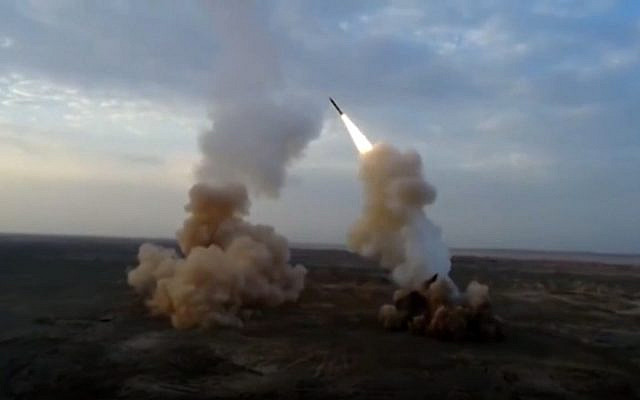The next Iranian missile attack

October 7th provided an apocalyptic preview of the end of the Jewish state on the ground. April 13th afforded a preview of the apocalypse from the air. Had one of the few missiles that managed to penetrate Israel’s air defense shield been fitted with a nuclear warhead, the outcome would have been devastating. This is why the phenomenal achievement of the Israeli Air Force and its allies on the night of the Iranian missile attack must not blind us to the danger ahead.
* * *
The Iranian drone and missile strike on Israel was unprecedented in at least three ways.
First, it was an overt, powerful and direct attack on Israel from Iranian territory. The Islamic Republic of Iran launched more than 300 missiles and drones carrying an estimated 60 tons of explosives in a synchronized manner designed to achieve near-simultaneous detonation over Israeli territory. It is difficult to regard such an attack as anything but a declaration of war.
Second, the 120 medium-range ballistic missiles fired at Israel on the night of April 13th, 2024 constitute one of the largest ballistic missile barrages in history—certainly in the history of the region. By comparison, in the “War of the Cities” that ended the Iran-Iraq War in 1988, Saddam Hussein fired more than 200 short-range Scud missiles at dozens of Iranian cities, but he did so over the course of two months at an average rate of three missiles per day. The Iranians retaliated with more than 100 missiles over a similar time frame. Three years later, during Operation Desert Storm, Saddam launched around 40 short-range Scud missiles at Israel (and almost 90 in total at countries in the region) over the course of three weeks. Russia’s most formidable aerial attack on Ukraine in the last two years featured some 150 projectiles, the vast majority of which were cruise missiles and drones.
Third, the extraordinary scale of the attack was matched by the staggering success in thwarting it. Forty years ago, when US President Ronald Reagan, seeking to escape the macabre logic of “mutually assured destruction,” conceived of an ambitious missile defense program, he was ridiculed for his delusions of “Star Wars.” On the night of April 13th, millions of Israelis witnessed Star Wars in action in the skies above Jerusalem. The interception of 99% of the missiles and drones launched at Israel was an astonishing triumph of missile defense technology.

But the extraordinary efficacy of Israel’s missile defenses must not breed complacency. Why?
For starters, the flagrant assault on Israeli territory represents a stark failure of Israeli and American deterrence. It is doubtful whether Iran would have dared to attack a reputed nuclear power had its leaders not calculated that Israel was weak, internally divided, and increasingly isolated on the world stage. In that respect, the earthquake of October 7th continues to produce negative aftershocks throughout the region, despite the destruction Israel is wreaking in Gaza. Iran’s brazen attack – in blatant defiance of the presidential “don’t” – also demonstrates profound disdain for US power, as well as growing comfort in the security afforded by the Russian-Chinese axis.
More importantly, the attack sets a very dangerous precedent for the future.
Let us be honest: the magnificent air defense operation mounted by Israel, the United States, and their regional allies was executed under ideal conditions. This time the defenders received more than a week’s warning and benefitted from remarkably precise intelligence. Those conditions may not pertain in the future. The next Iranian barrage may catch Israel and its allies by surprise, perhaps in the midst of an all-out war. Moreover, the Iranians are bound to learn from their resounding failure. The Soviet-American Cold War competition for supremacy produced such innovations as decoy warheads and multiple independently targetable reentry vehicles. These and other innovations would significantly complicate a future interception effort.
In addition, it will be difficult if not impossible to bear the costs of defense over time. The story of Iron Dome vs. the Qassam rocket illustrates the inherent economic advantage of the attacker in the battle between missiles and interceptors. The price tag of that one heroic night of defense on April 13th is estimated at more than $1 billion. It is doubtful that the Iranians spent even a quarter of this amount on the attack. To be sure, the cost of the defensive effort must also take into account the value of the damage prevented. Which is where a more fundamental economic reason for concern enters the equation: scarcity. Iran can field thousands of ballistic missiles. How many Arrow interceptors does Israel possess – and how quickly can it replenish those that are used up? The number of interceptors any defender has at his disposal is ultimately limited. A strategy of pure defense will prove to be unsustainable against determined foes.
Above all, this time the Islamic Republic of Iranian chose to attack Israel using conventional missiles. In the future, other types of missiles might be used. And while a 99 percent rate of interception is more than adequate for conventional missiles, it would be patently unacceptable for nuclear missiles. Consider this scenario: The year is 2034. The Iranians are in possession of several dozen nuclear warheads. They launch a barrage of ballistic missiles at Israel. Decision makers have 12 minutes at their disposal to assess the nature of the attack and decide on a response. How will they know in real time whether the missiles flying towards them are armed with conventional or nuclear warheads? Perhaps only a handful of them are nuclear-tipped? Which ones are they? The honest answer is that Israelis would not know what the incoming warheads contained until they were intercepted or, God forbid, exploded over Israeli territory. But wouldn’t the Iranians be out of their minds to launch nuclear missiles at a country that they suspect has the capacity to retaliate in kind? Maybe so. But then again maybe not. One need only imagine a Russian missile strike against the continental United States involving 120 ICBMs of unknown character to understand the ominous significance of Iran’s recent attack.
All of which is to say: Israel and its allies should not draw excessive comfort from the defensive success of April 13th. A red line has just been crossed. It will be more easily crossed in the future. So as decision-makers debate the appropriate response to the Iranian attack – and consider a broader strategy to counter Iranian aggression – they must remember that history may not repeat itself. The next attack could be far more deadly.

